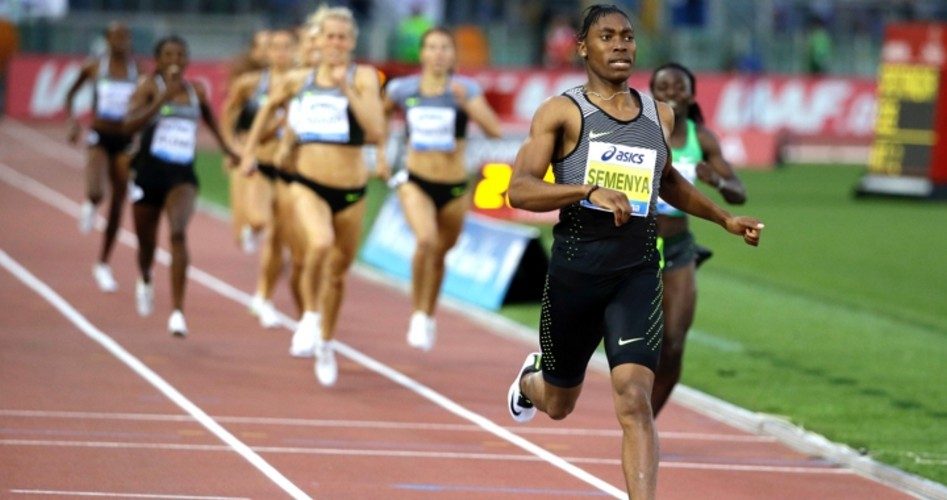
With reports of dead bodies and excrement floating in the water, the threat of Zika, and the Russian doping scandal, the Rio Olympics appears the Frankenstein of athletic events. And now Rio seems dopey in another way: Owing to political correctness, a runner with, reportedly, no uterus or ovaries but internal testes will be allowed to compete with women.
This person is South African middle-distance competitor Caster Semenya (shown). I wrote of Semenya in 2009, back when Semenya (I’m not satisfied that Semenya is female, so henceforth I’ll refer to the runner not with pronouns but as “CS”) was an 18-year-old phenom who’d just set a record while winning a world title, dusting female opponents in the process. These outstanding results, along with CS’s masculine physique, caused suspicion and led to tests to determine the athlete’s sexual status.
Now, I’d predicted that CS would be found to have internal testes. It wasn’t just the runner’s results and physique, which looked much like that of an 18-year-old boy. CS’s voice is so deep that a sportswriter who conversed with the runner on the phone said “I thought I was speaking to a man”; in addition, CS has masculine facial structure and very boyish mannerisms (video here; forward to 1:30). It was obvious from the get-go this was no normal individual.
When the predictable sex-test results came in reportedly showing CS was a hermaphrodite, the athlete was suspended, and I’d supposed that CS’s running days were over. Thus was I shocked to learn, just recently, that the South African would be competing in the Rio Olympics. They say CS is a shoo-in for a gold medal.
It turns out that CS’s suspension was temporary; the runner was allegedly allowed to compete under the condition CS take female hormones to counterbalance CS’s testosterone levels, which were more than three times that of a normal woman.
This alleged female hormone therapy, not surprisingly, had caused CS’s results to decline markedly, and the runner stopped making headlines. But now CS is back and, apparently as testosterone-fueled as ever, has returned to CS’s previous form.
The issue is that the International Association of Athletics Federation’s (IAAF’s) rules limiting “the amount of naturally occurring functional testosterone for female athletes were suspended last year,” wrote Eurosport. The reason? Get this: The site reports that “the Court of Arbitration in Sport [ruled] that the IAAF had insufficient evidence to back up the belief that excessively high levels of natural testosterone produced exceptional performances by women.”
So just ignore the man behind the curtain (or is it really a man?). It’s pure coincidence that when boys the world over reach puberty and their testosterone kicks in, they rapidly develop muscle mass and become dramatically more powerful; it also must be coincidence that in the rare cases of boys with conditions that prevent their entering puberty, this doesn’t happen. And perhaps now we can rescind rules prohibiting the use of steroids — artificial male hormones — because, hey, is there really any “proof” they enhance athletic performance? This all reminds me of noted feminist Camille Paglia’s incredulity at how dunderhead 1970s feminists would corner her on college campuses and insist that hormones didn’t exist and, even if they did, there’s no way they could influence behavior. And the Left calls conservatives unscientific?
Yet the political-correctness-induced irrationality surrounding this case doesn’t end there. The AP’s Gerald Imray writes, in a statement as foolish as it is fashionable, “Nobody can dictate to Semenya what gender she is.” Yet the issue here isn’t “gender.” Note that the psychobabblers who co-opted the term (it once was used almost exclusively in reference to words) and birthed the “gender” agenda tell us that “gender” and “sex” are not synonymous. The latter is a biological classification — and thus objective — while “gender” is subjective; it’s a person’s perception of what he is. The male/female division in sports, however, is based on sex. And when making objective judgments affecting everyone, one individual’s subjective (mis)judgments are irrelevant.
Imray also writes, “Opponents of the testosterone rule pointed to the natural advantages of other athletes that aren’t regulated, such as Usain Bolt’s fast-twitch muscle fibers, Michael Phelps’ big wingspan and former cyclist Miguel Indurain’s huge lung capacity.” But IAAF consultant Joanna Harper, expressing some rare common sense, “explained that sports competitions don’t have categories for athletes with slow twitch, short arms or small lungs,” Imray informed. Yet we do have separate categories for men and women.
So what we’re witnessing here is sophistry. If you believe division based on muscle fibers, arm length, or lung capacity is warranted, lobby for it; if you think the male/female division is as silly as the old Negro Leagues, lobby to have it eliminated. But if we accept its legitimacy, then the central rule distinguishing the category must be observed.
Related to this, one argument of those opposing the “testosterone rule” is that as with height, strength, or lung capacity, CS’s elevated testosterone level is a “naturally occurring advantage.” True. But here’s another “naturally occurring advantage”: being male. So why not let men compete in women’s sports? Oh, because then they wouldn’t be “women’s sports”? Exactly.
And this brings us to the point. My belief is that everyone is either male or female and that any confusion is the result of abnormalities; of course, today’s politically correct view is that sex is a “continuum” and that people such as CS are “intersex.” But if a continuum and nothing else exists, there can’t be the designation “female” — and then it makes no sense to have “female” sports. But if the designation is something real, then not only is the women’s sports classification lent legitimacy but also the rule distinguishing it: that it’s limited to women.
So what of the curious case of Caster? With a vagina but no uterus or ovaries and undescended testicles (they normally descend into a boy’s scrotal sac during intrauterine development), CS could be an abnormally developed male. After all, CS certainly is in the male category in at least one respect: The runner is attracted to women and has a “wife.” And while knowing whether CS has an XY chromosome configuration would be instructive, political correctness prevents thorough examination of such matters; thus, a genetic test either hasn’t been conducted or its results haven’t been revealed. Then there’s the fashionable view that, as the New York Daily News put it, “Caster Semenya … is a woman … and a man”; or, as the activists may say, is “intersex.” But this admission alone should close the case: It’s “women’s sports,” not “women’s and people in-between’s sports.” Definitions define — and limit. And if having internal testes doesn’t disqualify you from women’s athletics, what does?
This case speaks volumes about our time, in that it reflects the attack on the concept of normalcy. Because one to two percent of people are hermaphroditic or suffer with some other sexual abnormality, so-called experts contend that “defining sex is difficult,” as if 98 to 99 percent consistency isn’t enough to indicate normality. Speaking of which, what of that comparison between height or lung-capacity advantages and CS’s condition? Well, here’s a clue: Height, lung capacity, and other qualities mentioned are normal variation. Having internal testes isn’t normal, not any more than is spina bifida or Down syndrome.
Yet as abnormal as conditions such as CS’s are, they now won’t be so rare in Rio, where, says IAAF consultant Harper, there may be “an all-intersex podium in the 800 [meter].” “Women’s” sports?
And that’s the irony: In a sense, liberalism gave us women’s sports. Now liberalism is taking them away.
Contact Selwyn Duke, follow him on Twitter or log on to SelwynDuke.com



